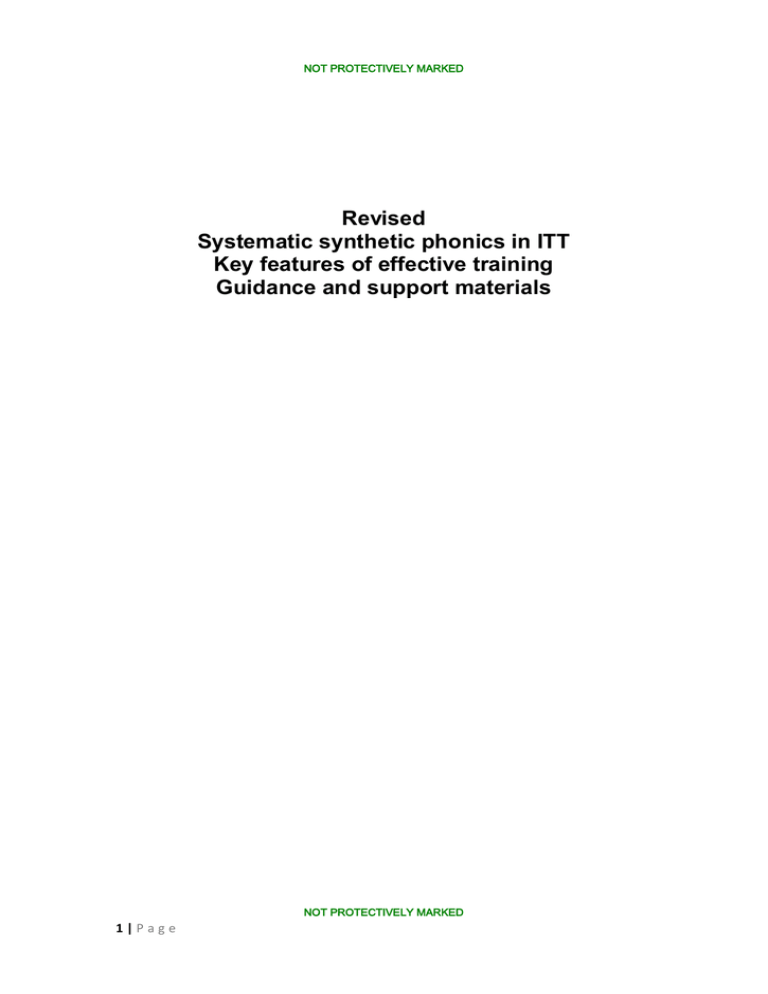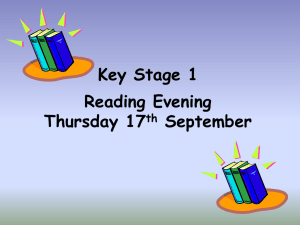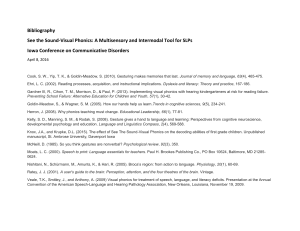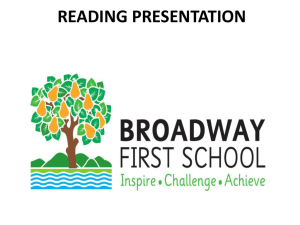Revised Systematic synthetic phonics in ITT Key features of effective training
advertisement

NOT PROTECTIVELY MARKED Revised Systematic synthetic phonics in ITT Key features of effective training Guidance and support materials NOT PROTECTIVELY MARKED 1|Page NOT PROTECTIVELY MARKED Introduction This document is intended to support initial teacher training (ITT) providers in strengthening provision. It provides a specific focus on the teaching of systematic synthetic phonics as the prime approach to decoding print and an essential component of the teaching of early reading. This priority is set out in the new Teachers’ Standards (DfE 2011) as follows: Standard 3 A teacher must demonstrate good subject and curriculum knowledge if teaching early reading, demonstrate a clear understanding of systematic synthetic phonics The main audience will be primary ITT tutors, colleagues from their partner schools and trainee teachers. However, all providers of primary and secondary ITT need to be aware of this priority area. Guidance The first part of the document provides guidance on training outcomes for NQTs in relation to the systematic synthetic phonics element of the Teachers’ Standards. Alongside this, the guidance identifies significant features of ITT provision which can support ITT providers, working with their partner schools, in ensuring that trainee teachers achieve the described outcomes. Supporting Papers and Materials The second part of the document includes papers and materials designed to support ITT providers in ensuring that trainee teachers meet the outcomes set out in the guidance. It exemplifies both training outcomes and effective ways of working. The papers and materials in the document are intended to be used flexibly to provide a focus for the on-going development of provision in this priority area; they can be used to support auditing, evaluation and training. This part of the document also contains the Criteria for assuring high quality phonic work (DfE 2011). NOT PROTECTIVELY MARKED 2|Page NOT PROTECTIVELY MARKED Guidance The following guidance provides a specific focus on training for the teaching of systematic synthetic phonics. This is set out in the Teachers’ Standards as: Standard 3 A teacher must demonstrate good subject and curriculum knowledge - if teaching early reading, demonstrate a clear understanding of systematic synthetic phonics (Teachers Standards DfE 2011) In order to meet this standard trainee teachers should, by the end of their training and with appropriate induction support: understand the role of word recognition in the Simple View of Reading. (The Independent Review of the Teaching of Early Reading, Final Report, DfES 2006) know and understand the alphabetic code know and understand the Criteria for assuring high quality phonic work and be able to recognise how they are met in a range of phonic programmes be able to apply their knowledge and understanding of the Criteria to the teaching and assessment of phonics using a school’s phonic programme, providing effective support for all children be able to identify and provide targeted support for children making progress both beyond and below the expected level To ensure that trainee teachers achieve these outcomes ITT providers, planning and working with their partner schools, should consider: providing a joint plan of centre-based and school-based training which sets out how and where trainees will gain the relevant knowledge and expertise (Paper 2) Identifying and working with highly effective phonics teachers from partner schools to ensure trainee teachers: o are inducted into using a school’s phonics programme o are trained in teaching and assessing using a school’s programme o evaluate their own practice (Papers 2, 3, 4) NOT PROTECTIVELY MARKED 3|Page NOT PROTECTIVELY MARKED ensuring trainee teachers take responsibility for finding out about and reviewing partner schools’ phonic programmes through discussions with other trainees, tutors and teachers (Papers 3, 4) monitoring and evaluating the implementation and outcomes of the training (Paper 2) Supporting Papers and Materials 1. Introducing systematic synthetic phonics: a short introduction to systematic synthetic phonics. This can be used to support trainee teachers and others in developing their understanding of systematic synthetic phonics. This document also provides an overview, based on the Criteria for assuring high quality phonic work, of what trainee teachers need to know and be able to do in order to make effective use of systematic synthetic phonics programmes in their teaching. Page 5 2. Key features of effective provision - implementing the guidance in practice: additional detail exemplifying what ITT providers can do to support trainees in achieving the outcomes set out in the guidance. Page 9 3. Working with SSP programmes - matching table: support for trainee teachers and others in matching the essential generic elements of systematic synthetic phonics to the specific programme they will work with in a given school. Page 11 4. Supporting trainee teachers in working with SSP programmes This document provides prompts for ITT providers, partner schools and phonics developers for supporting trainee teachers and new teachers in being able to teach effectively using the range of phonics programmes. Page 13 5. Criteria for assuring high quality phonic work (DfE 2011) Page 15 6. Case studies from ITT partner schools (to follow - in draft) 7. Exemplification of what works well in systematic synthetic phonics in ITT from ITT partnerships (to follow) Please note The Independent Review of the Teaching of Early Reading is an additional and significant resource. It sets out a series of recommendations for the effective teaching of early reading. It presents the Simple View of Reading and makes recommendations for the systematic teaching of phonics. This report underpins and informs the materials contained in this booklet. (DfES March 2006. Rose, J. Ref: 0201-2006DOC-EN). NOT PROTECTIVELY MARKED 4|Page NOT PROTECTIVELY MARKED 1 Introducing Systematic Synthetic Phonics Spoken words and written words Language is made up of words. Words are made up of sounds (phonemes). When we write, we use written symbols (graphemes) to represent the sounds. These graphemes may be single letters or combinations of letters such as sh, oy and igh. Once we know how these grapheme-phoneme correspondences (GPCs) work we can encode spoken words in writing for others to read, and we can decode words that others have written. Synthetic phonics The ‘synthetic’ part of the term ‘synthetic phonics’ comes from the part played by synthesising (blending) in reading as outlined below. Children are taught grapheme-phoneme correspondences and how to use this knowledge to work words out from the beginning, starting at the simplest level: For reading, children are taught to look at the letters from the left to right, convert them into sounds and blend (synthesise) the sounds to work out the spoken forms of the words. For example, if children see the word hat, they need to know what sound to say for each grapheme (/h/ - /a/ - /t/) and then to be able to blend those sounds together into a recognisable word. Once words have been read this way often enough (and this can vary from child to child), they become known and can then be read without sounding out and blending. For spelling, children are taught to segment spoken words into sounds and write down graphemes for those sounds. For example, if children want to write hat, then they need to be able to split it into the sounds /h/ - /a/ - /t/ and write the appropriate letters. Learning to read and write in English is particularly difficult because written English uses a complex alphabetic code, which is why it needs to be taught by a systematic approach which goes from the simple to the more complex. Starting at the simplest level means that learning to read and spell can be as easy in English at this stage as in other languages which are alphabetically written. Children can thus grasp the basic workings of alphabetic writing before they have to start dealing with the complexities which are unavoidable in English. By clearly defining what should be known at each stage, synthetic phonics programmes allow the early identification of children who are falling behind and of the areas where they need help (e.g. remembering GPCs, blending, segmenting). Prompt help can prevent long-term problems. NOT PROTECTIVELY MARKED 5|Page NOT PROTECTIVELY MARKED Synthetic phonics programmes typically teach children: 1. Grapheme-phoneme correspondences (GPCs) at the rate of about three to five a week, starting with single letters and a sound for each then going on to the sounds represented by digraphs (e.g. sh and oo) and larger grapheme units (e.g. air, igh, eigh). 2. Blending of phonemes for reading, starting after the first few GPCs have been taught and working with more GPCs as they are taught. 3. Segmenting for spelling, again starting after the first few GPCs have been taught and working with more GPCs as they are taught. 4. The most common spellings for sounds first, later introducing alternative sounds for spellings and alternative spellings for sounds. 5. Strategies for reading and spelling common, high frequency, words containing unusual GPCs. 6. To apply word-reading skills in reading books which are closely matched to their developing skills – level-appropriate decodable texts – to support them in using their phonemic strategies as a first approach to reading and spelling and to experiencing success. Systematic synthetic phonics programmes These programmes provide a systematic, orderly, teaching framework through which teachers can support children in developing the phonic knowledge and skills and in securing the word recognition skills to support them as fluent readers. Why is it more difficult to learn to read and write in English than in other languages? One reason for the complexity of the English alphabetic code is that changes in pronunciation over the centuries have not always been accompanied by changes in spelling. Another reason is that English has absorbed many words from other languages, often retaining their original spellings. In English, much more than in other languages, many letters or letter-combinations can commonly represent more than one sound – for example ea as in heat and head; most sounds can be spelt in more than one way – for example the vowel sound in heat is also commonly spelt as in he, see, chief and complete; NOT PROTECTIVELY MARKED 6|Page NOT PROTECTIVELY MARKED Some very common words contain grapheme-phoneme correspondences that occur in few if any other words – for example one, two, are, said, great, people, laugh. In spite of the complexity and the exceptions, however, it is still very important to teach children how the alphabetic code works in English. Without this teaching, many children start thinking that all words have to be individually learnt; this is an impossible task, and once children get the idea that they have to ‘learn words’ in order to be able to read, this mindset can take over at the expense of a decoding mindset. There is very much less learning to do if children are taught how the alphabetic code works and can understand the underlying logic which underpins all word-reading (see Paragraphs 55 and 56 of Appendix 1 in Jim Rose’s Independent Review of the Teaching of Early Reading, 2006). In practice, many children start to self-teach long before all GPCs have been explicitly taught. A good programme, if followed carefully, will ensure that the teaching is sound, even if the programme differs in some respects from other programmes. Using a Systematic Synthetic Phonics Programme. The following section, based on the Criteria for high quality phonic work (appendix 5 ), sets out what newly qualified teachers need to be able to do to make effective use of systematic synthetic phonics programmes in their teaching of reading and writing. They need to be able to: 1. 2. 3. 4. 5. 6. support children in learning phonic knowledge and skills using a systematic, synthetic programme, with the expectation that they will be fluent readers having secured word recognition skills by the end of key stage one plan for and teach discrete, daily sessions of phonics, progressing from simple to more complex phonic knowledge and skills and covering the major grapheme/phoneme correspondences assess children's progress in phonic knowledge and skill use a multi-sensory approach so that children learn variously from simultaneous visual, auditory and kinaesthetic activities which are designed to secure essential phonic knowledge and the skills of blending and segmenting teach how phonemes can be blended, in order, from left to right, 'all through the word' for reading teach how to segment words into their constituent phonemes for spelling and that this is the reverse of blending phonemes to read words NOT PROTECTIVELY MARKED 7|Page NOT PROTECTIVELY MARKED teach children to apply phonic knowledge and skills as their first approach to reading and spelling even if a word is not completely phonically regular 8. teach high frequency words that do not conform completely to grapheme/phoneme correspondence rules 9. teach to the systematic teaching framework of the programmes they are working with 10. when children are in the early stages of learning phonics, use decodable texts of the appropriate level where children can apply and practise the phonic knowledge and skills they have learnt and can experience success by relying on phonemic blending. They should not be expected to use strategies such as whole-word recognition and/or cues from context, grammar or pictures. 7. NOT PROTECTIVELY MARKED 8|Page NOT PROTECTIVELY MARKED 2 . Key features of effective provision: implementing the guidance in practice To support trainees in achieving the outcomes set out in the guidance, ITT providers, planning and working with partner schools so that roles are defined and coordinated across training, should consider the following. Centre-based training which includes: planned and explicitly sign-posted opportunities for all trainee teachers to be taught, re-visit and apply their knowledge of systematic synthetic phonics to teaching reading and writing trainees being taught to identify the principles and practices of high quality systematic synthetic phonics within the phonic programmes they work with so they can use them effectively in teaching.(Papers 3,4) School-based training which includes: Explicit training in how to teach and assess using the school’s phonics programme Planning phonic lessons with a teacher Observing highly effective teachers model phonic lessons Partner teaching with an effective teacher of phonics Being observed by the teacher and given feedback Training in how to teach individual children who are in danger of falling behind (Papers 3,4) Monitoring, evaluating and auditing which includes: clearly and coherently mapping and monitoring where training for the use of systematic synthetic phonics takes place across centre and school-based training and independent learning, with agreed roles and responsibilities for school and centre-based staff and trainee teachers . explicit systems for assessing, evaluating and tracking trainees’ knowledge and understanding of the use of systematic synthetic phonics to teach and assess reading and writing. provision for personalised training programmes to address trainees’ needs, including support with phoneme discrimination: to segment (hear) and enunciate (say) phonemes clearly. NOT PROTECTIVELY MARKED 9|Page NOT PROTECTIVELY MARKED Strategic planning by the ITT provider working with partner schools and quality assurance which includes: provision for monitoring the use of systematic synthetic phonics to teach and assess reading and writing across school- and centre-based training effective deployment of resources (including staff expertise and time) to support provision for systematic synthetic phonics mechanisms for identifying and addressing the training needs of centre- and school-based staff, including mentors quality-assured training for school-based mentors, and other staff involved in training, on the effective use of systematic synthetic phonics to teach and assess reading and writing, to ensure shared understandings and expectations. Improved outcomes for trainees, demonstrated by: on-going data from Ofsted inspections, course evaluations, TDA visits, exit surveys, NQT survey and other evidence evidence of trainees’ ability to use systematic synthetic phonics to teach and assess reading and writing, collected and reviewed by literacy subject specialists evidence analysed and presented against the relevant Standards and sections of the TDA Self-Evaluation Document. NOT PROTECTIVELY MARKED 10 | P a g e NOT PROTECTIVELY MARKED Paper 3. Working with systematic synthetic phonics programmes: matching table A challenge for trainee teachers and teachers is working with an unfamiliar phonics programme and being able to use it effectively in their teaching. The purpose of this document is to provide support in identifying the typical features of teaching synthetic phonics as they appear in the range of systematic synthetic phonics programmes which meet the DfE Criteria for assuring high quality phonic work (appendix 5). The left-hand side of the table provides a list of the typical features of the programmes; these reflect the DfE Criteria for assuring high quality phonic work. The right-hand side allows for a summary of how each of those features is taught, and where, within a given programme. It also suggests that any questions are noted. Typical features of a systematic synthetic phonics programme Name of programme Review the phonics programme and note in the column below how each feature is introduced and taught in this programme. Also note any questions this raises for you or issues you want to explore further. Grapheme-phoneme correspondences (GPCs) introduced at the rate of about 3 to 5 a week, starting with single letters and a sound for each, then going on to the sounds represented by digraphs (e.g. sh and oo) and larger grapheme units (e.g. air, igh, eigh) Blending of phonemes for reading, starting after the first few GPCs have been taught and working with more GPCs as they are taught NOT PROTECTIVELY MARKED 11 | P a g e NOT PROTECTIVELY MARKED Segmenting of phonemes for spelling, again starting after the first few GPCs have been taught and working with more GPCs as they are taught Introduction of the most common spellings for sounds first and then introduce alternative sounds for spellings and alternative spellings for sounds Introduction of strategies for reading and spelling common high frequency words containing unusual GPCs Provision of opportunities for the application of word-reading skills in reading books which are closely matched to children’s developing skills – level appropriate decodable texts – to support children in using their phonemic strategies as a first approach to reading and spelling and to experiencing success. NOT PROTECTIVELY MARKED 12 | P a g e NOT PROTECTIVELY MARKED Paper 4 Supporting trainee teachers in working with systematic synthetic phonic programmes A challenge for many trainee teachers is to teach using the range of different phonics programmes, both commercial and school-developed, that they meet in schools. This document provides a model of effective practice for ITT providers, schools and phonic programme developers, setting out what they can do to support trainees in working effectively with the range of programmes and in being able to identify the principles and practices of systematic synthetic phonics within each phonics programme. This document is intended to be used flexibly to support local developments. Programme developers and trainers can Consider providing a short guide or other supporting resources for trainee teachers (and new teachers) and the teachers and tutors who work with them, including: an overview of the programme an introduction to resources and how to use them an explanation of how the programme reflects the DfE criteria for assuring high quality phonic work. ITT providers can Support trainees in understanding: what a systematic synthetic phonics programme is and the elements which different programmes should have in common the DfE criteria for assuring high quality phonic work for phonics programmes, and the principles and practices of high quality phonic work how to recognise these in different programmes to inform their teaching the alphabetic code and that it may be taught differently across programmes. Ensure that tutors working with trainees in schools know the programmes used in the schools and the methods used for teaching with them. Draw on the expertise from partner schools, to demonstrate and support teaching using different phonic programmes. Have a range of information available about the programmes used in partner schools, including, copies of resources and video of effective practice. Work with schools to set out agreed expectations and outcomes for trainees during a given placement. Ensure there are clear, shared expectations in relation to the induction of NOT PROTECTIVELY MARKED 13 | P a g e NOT PROTECTIVELY MARKED trainees to the schools’ programmes and their on-going support with defined roles for: tutors, trainees and schools. Work in partnership with schools to identify how support for trainees in using their phonics programme can result in additional support for children’s reading progress. Schools can Introduce the trainees to the SSP programme used in the school. Identify key school staff to oversee trainee induction and on-going work with their phonics programme, including for example explaining how the programme supports: differentiation identification and provision of extra support for pupils making progress below expectation and how it reflects the DfE criteria for assuring high quality phonic work for phonics programmes. Support trainees in developing their teaching of phonics using the school’s programme, through, for example: shared planning; teacher modelling; assisted teaching; team-teaching; one- to-one tuition; small group work. Trainee teachers can Take responsibility for finding out about the programmes they are going to work with through discussions with other trainees, tutors and teachers. Read support materials and observe teaching using the programme. Review commercially and school-developed phonic programmes, using the DfE criteria for assuring high quality phonic work. Share and test their knowledge about systematic synthetic phonics programmes with other trainees, for example through: workshops, blogs, Virtual Learning Environments (VLEs). Ask questions about how the school’s phonics programme works, including: how it is applied to reading and writing how it supports assessment how it addresses all children’s reading and writing needs Negotiate and be proactive in seeking opportunities to observe, teach and be observed teaching different stages of phonics progression using the school’s phonics programme NOT PROTECTIVELY MARKED 14 | P a g e NOT PROTECTIVELY MARKED Paper 5. The criteria for assuring high quality phonic work (DfE 2011) The criteria for assuring high quality phonic work provide schools with clearly defined key features of an effective, systematic, synthetic phonics programme. Publishers of products can submit self-assessments and their products to be reviewed against the core criteria by independent evaluators. These publishers should contact the phonics mailbox to request a self-assessment form. They will then need to return the self-assessment form together with two copies of their product. A list of publishers and their self-assessments that have been reviewed as meeting the core criteria are available on the ‘Phonics Products and the Self-Assessment Process’ page. Published programmes for phonic work should meet each of the following criteria. Further explanatory notes are offered below. The programme should: present high quality systematic, synthetic phonic work as the prime approach to decoding print, i.e. a phonics ‘first and fast’ approach (see note 1) enable children to start learning phonic knowledge and skills using a systematic, synthetic programme by the age of five, with the expectation that they will be fluent readers having secured word recognition skills by the end of key stage one (see note 2) be designed for the teaching of discrete, daily sessions progressing from simple to more complex phonic knowledge and skills and covering the major grapheme/phoneme correspondences (see note 3) enable children's progress to be assessed (see note 4) use a multi-sensory approach so that children learn variously from simultaneous visual, auditory and kinaesthetic activities which are designed to secure essential phonic knowledge and skills (see note 5) demonstrate that phonemes should be blended, in order, from left to right, 'all through the word' for reading demonstrate how words can be segmented into their constituent phonemes for spelling and that this is the reverse of blending phonemes to read words ensure children apply phonic knowledge and skills as their first approach to reading and spelling even if a word is not completely phonically regular ensure that children are taught high frequency words that do not conform completely to grapheme/phoneme correspondence rules provide fidelity to the teaching framework for the duration of the programme, to ensure that these irregular words are fully learnt (see note 6) NOT PROTECTIVELY MARKED 15 | P a g e NOT PROTECTIVELY MARKED ensure that as pupils move through the early stages of acquiring phonics, they are invited to practise by reading texts which are entirely decodable for them, so that they experience success and learn to rely on phonemic strategies (see note 7). Explanatory notes 1. Phonic work is best understood as a body of knowledge and skills about how the alphabet works, rather than one of a range of optional 'methods' or 'strategies' for teaching children how to read. For example, phonic programmes should not encourage children to guess words from non-phonic clues such as pictures before applying phonic knowledge and skills. High quality systematic, synthetic phonic work will make sure that children learn: grapheme/phoneme (letter/sound) correspondences (the alphabetic principle) in a clearly defined, incremental sequence; to apply the highly important skill of blending (synthesising) phonemes, in order, all through a word to read it; to apply the skills of segmenting words into their constituent phonemes to spell; and that blending and segmenting are reversible processes. 2. Teachers will make principled, professional judgements about when to start on a systematic, synthetic programme of phonic work but it is reasonable to expect that the great majority of children will be capable of, and benefit from doing so by the age of five. It is equally important for the programme to be designed so that children become fluent readers having secured word recognition skills by the end of key stage one. 3. The programme should introduce a defined initial group of consonants and vowels, enabling children, early on, to read and spell many simple CVC words. 4. If the programme is high quality, systematic and synthetic it will, by design, map incremental progression in phonic knowledge and skills. It should therefore enable teachers to: track children's progress; assess for further learning and identify incipient difficulties, so that appropriate support can be provided. 5. Multi-sensory activities should be interesting and engaging but firmly focused on intensifying the learning associated with its phonic goal. They should avoid taking children down a circuitous route only tenuously linked to the goal. This means avoiding over-elaborate activities that are difficult to manage and take too long to complete, thus distracting the children from concentrating on the learning goal. NOT PROTECTIVELY MARKED 16 | P a g e NOT PROTECTIVELY MARKED 6. The programme should not neglect engaging and helpful approaches to the more challenging levels where children have to distinguish between phonically irregular graphemes and phonemes. 7. It is important that texts are of the appropriate level for children to apply and practise the phonic knowledge and skills that they have learnt. Children should not be expected to use strategies such as whole-word recognition and/or cues from context, grammar, or pictures. NOT PROTECTIVELY MARKED 17 | P a g e






